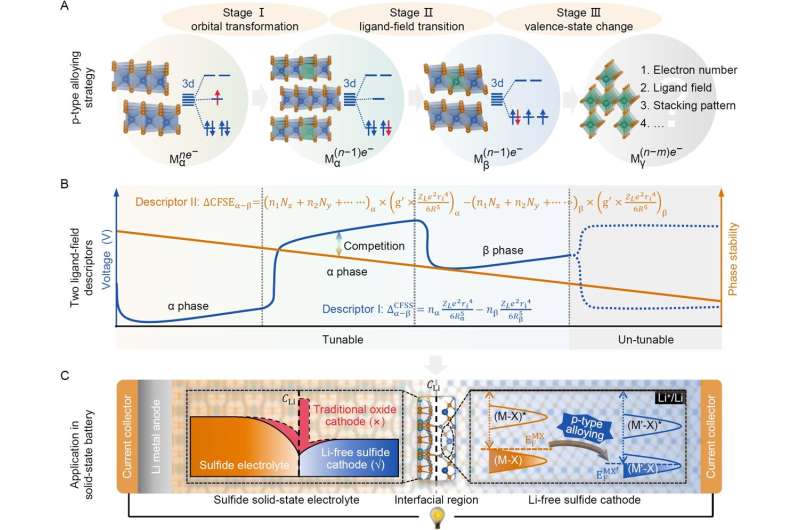This article has been reviewed according to Science X's editorial process and policies. Editors have highlighted the following attributes while ensuring the content's credibility:
fact-checked
trusted source
proofread
A new family of intercalation-type Li-free cathodes for all solid-state batteries with considerable energy density

The development of intercalation-type Li-free transition-metal-based cathodes and Li-metal anode paired all-solid-state batteries appears a viable alternative to overcome the energy density limitations faced by current rechargeable Li-ion technology. Additionally, it is noteworthy that the rate-determining process that limits the power density of all-solid-state batteries is no longer in the electrolyte component, but in the maximum resistance observed across the traditional Li-containing oxide cathode/electrolyte interfaces.
Thus, the Li-free cathodes can not only be matched with Li-metal anode to achieve a higher specific energy for all-solid-state batteries, their revival offers a solution for addressing large interfacial resistance caused by chemical incompatibilities between the traditional oxide cathodes and the most widely studied sulfide electrolytes.
More importantly, the exploration of such materials well address concerns over raw material availability caused by the ramp-up in Li-ion battery production. Specifically, commercial cathodes suitable for large-scale energy storage applications (e.g., electric vehicles) that demonstrate high energy density and lifetime are all reliant on Co or Ni to some degree.
This is concerning owing to their high costs, scarcities, and centralized/volatile supply chains. Therefore, the development and commercialization of Li-free cathodes without Co and Ni is critical for both all-solid-state battery and traditional Li-ion battery industry.
Recently, Prof. Siqi Shi from Shanghai University identified a crucial voltage-tuning/phase-stability competition that has been ever overlooked in the cathode systems. The, they proposed a p-type alloying strategy involving three voltage/phase evolution stages, of each which their varying trends were quantitated by two improved ligand-field descriptors to balance the above contradiction.
On this basis, a new intercalation-type Li-free cathode 2H-V1.75Cr0.25S4 was designed, which possessed a record energy density of >550 Wh kg−1 at electrode level, much higher than existing Li-free transition-metal-based electrodes (e.g., ~500 Wh kg−1 for TiS2), and comparable to the traditional Li-containing oxide cathodes.
Simultaneously, the design of such cathodes smoothed the Li+ distribution at the interface with sulfide electrolytes, thus addressing the interfacial compatibility challenges of traditional oxide cathodes in all-solid-state batteries.
This work opens up possibilities for customizing sulfide cathodes for all-solid-state Li-metal batteries through electronic band structure engineering, which radically transforms the academic and industrial views on electrode designing and interfacial controlling, and is critical to all-solid-state battery science and cathode chemistry urgently addressing Co/Ni resource scarcities.
The work is published in the journal National Science Review.
More information: Da Wang et al, A customized strategy to design intercalation-type Li-free cathodes for all-solid-state batteries, National Science Review (2023). DOI: 10.1093/nsr/nwad010


















